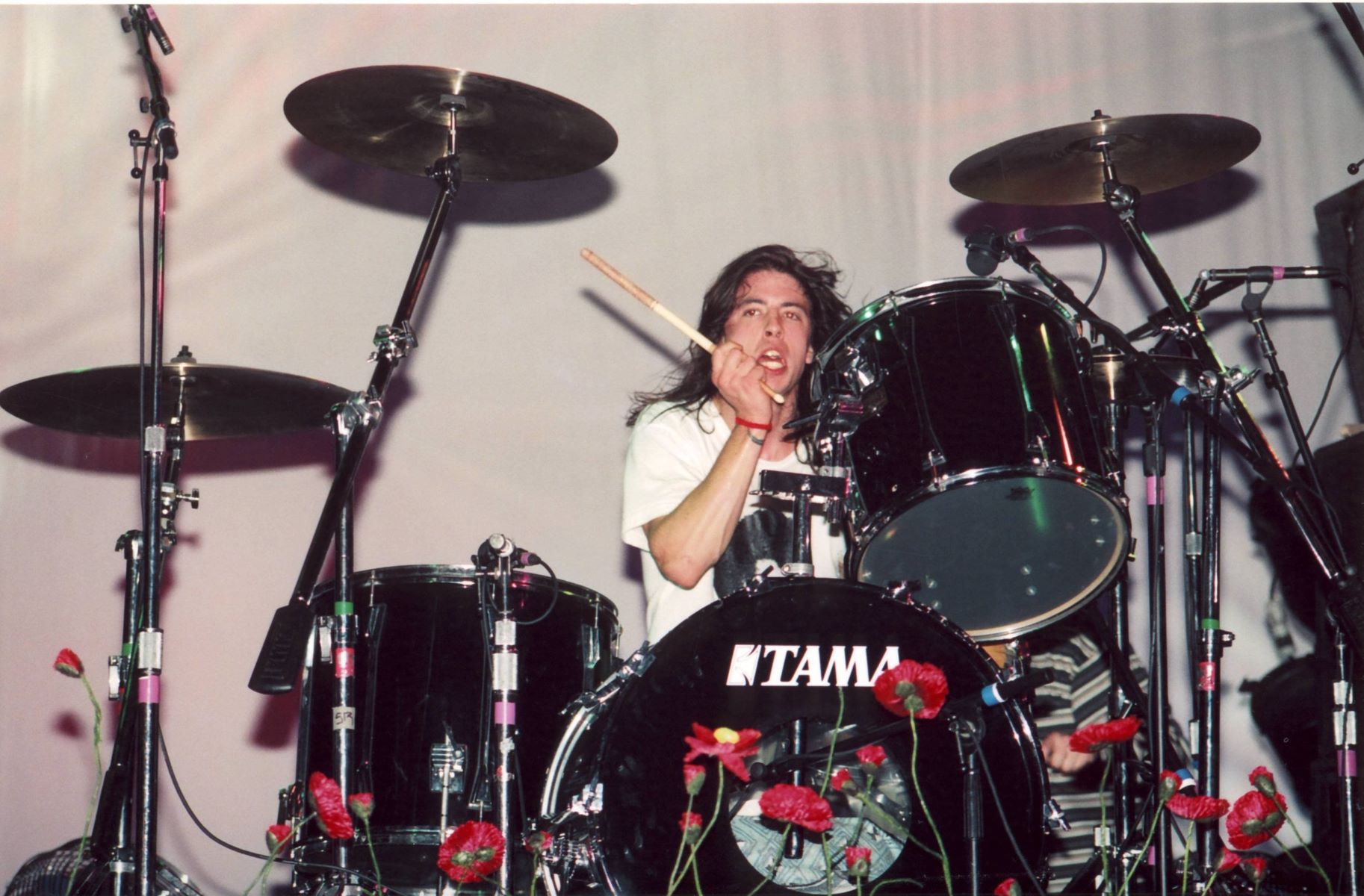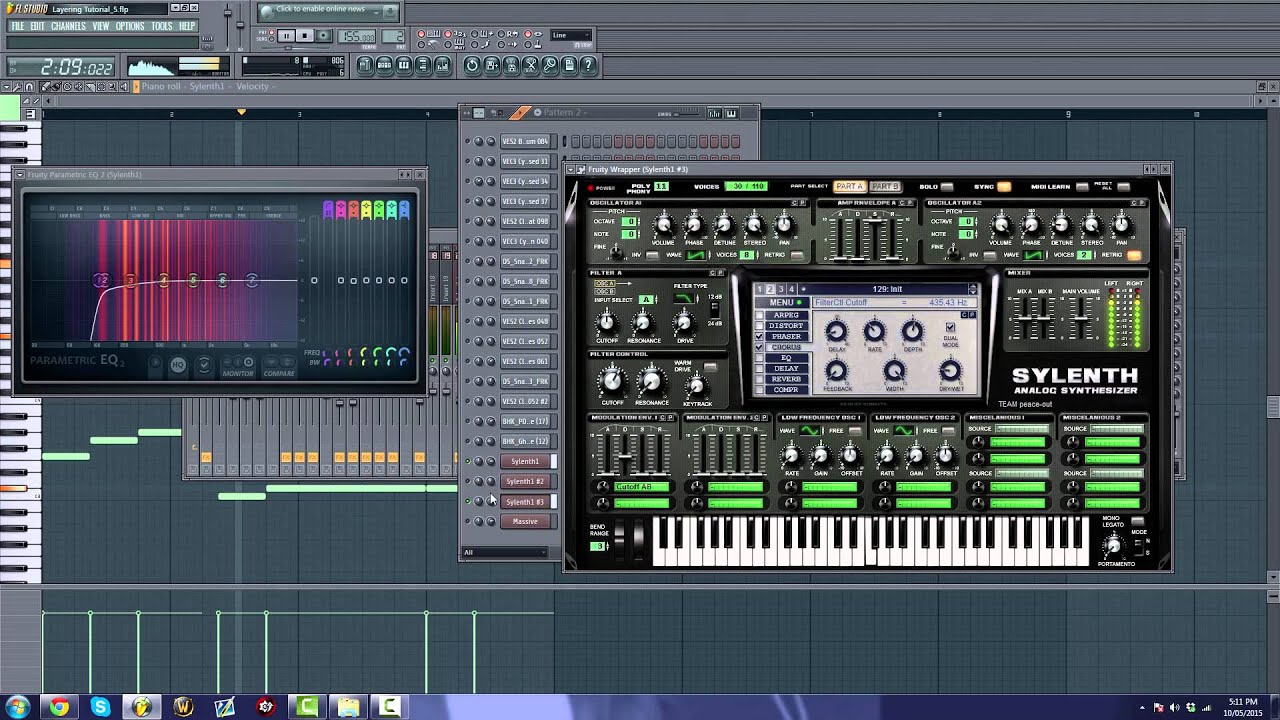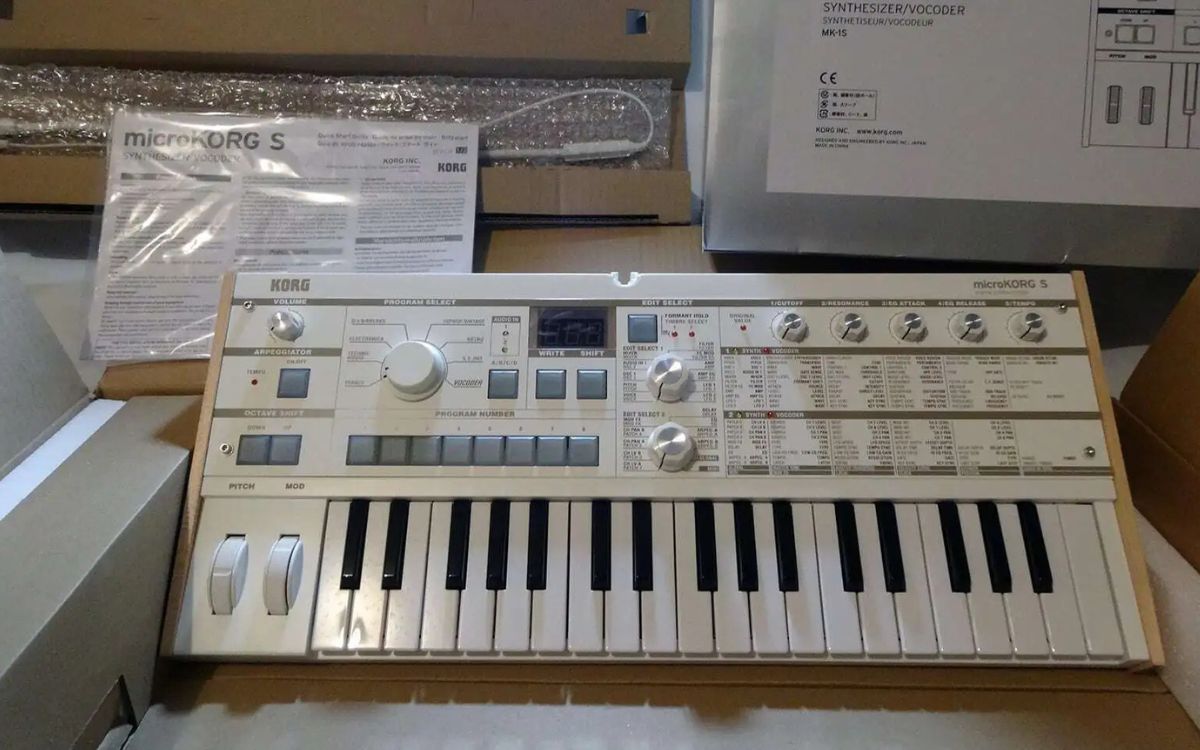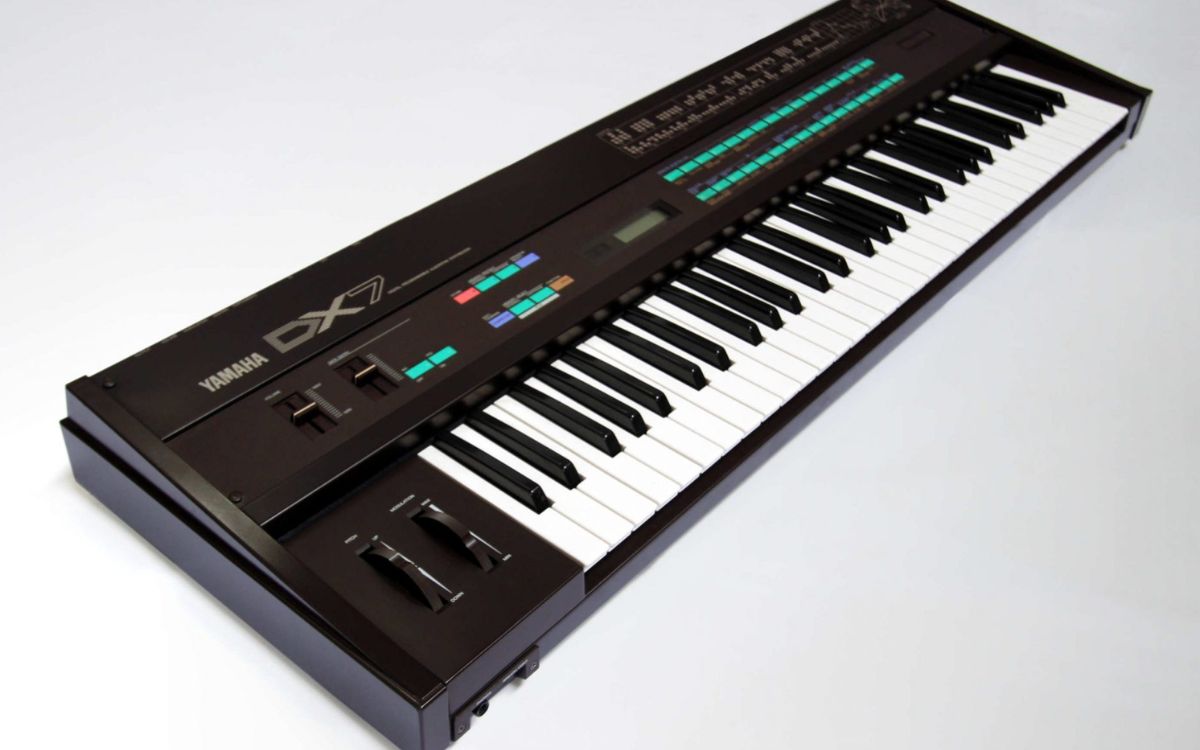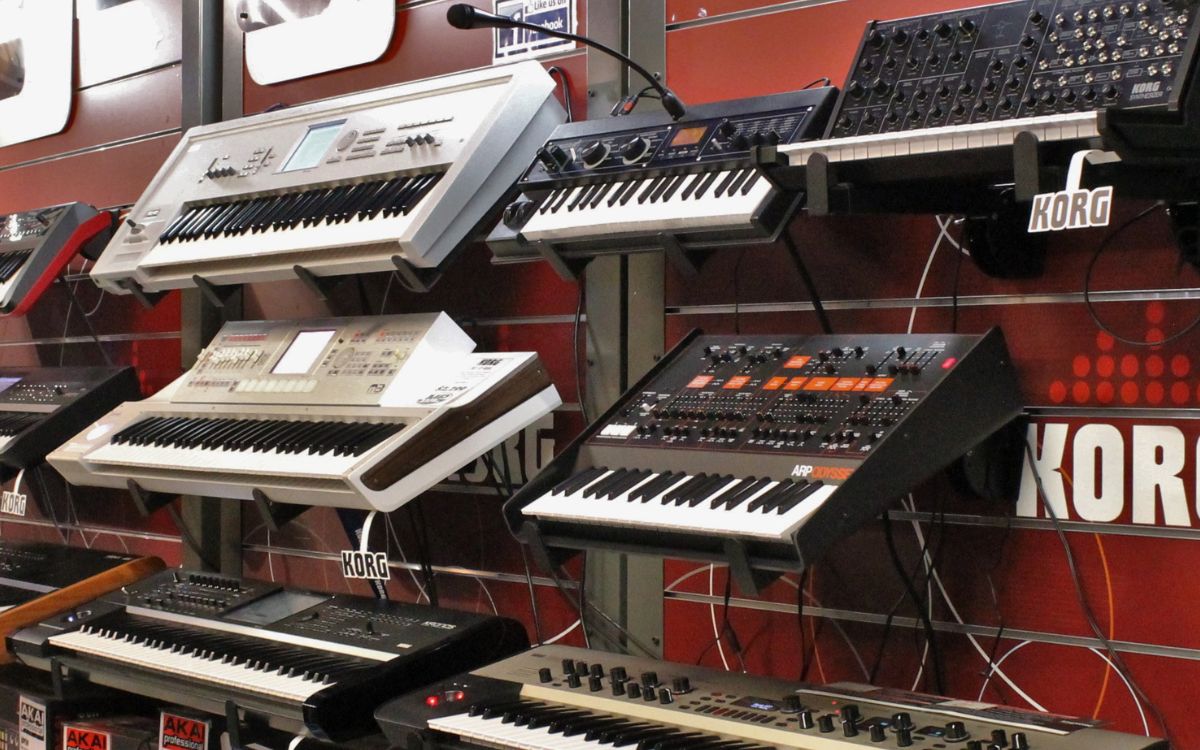Home>Instruments>Synthesizer>What Synthesizer Did Eddie Van Halen Use On The Album 5150


Synthesizer
What Synthesizer Did Eddie Van Halen Use On The Album 5150
Modified: January 22, 2024
Discover the iconic synthesizer Eddie Van Halen used on the album 5150. Explore the captivating sound and technical brilliance that defined this classic rock masterpiece.
(Many of the links in this article redirect to a specific reviewed product. Your purchase of these products through affiliate links helps to generate commission for AudioLover.com, at no extra cost. Learn more)
Table of Contents
- Introduction
- Background: Eddie Van Halen’s Synthesizer Usage
- The Making of Album 5150
- Synthesizer Choice for Album 5150
- Eddie Van Halen’s Preferred Synthesizer Features
- Recording Process with the Chosen Synthesizer
- Influence of Synthesizer Sounds on Album 5150’s Sound
- Legacy of Eddie Van Halen’s Synthesizer Usage
- Conclusion
Introduction
Eddie Van Halen, the legendary guitarist and co-founder of the band Van Halen, was not only known for his groundbreaking guitar skills but also for his innovative use of synthesizers. While primarily recognized for his virtuosity on the guitar, Van Halen incorporated synthesizers into the band’s sound, creating a unique blend of rock and electronic elements.
One of the albums where Eddie Van Halen’s synthesizer usage significantly stood out is the iconic “5150.” Released in 1986, this album marked a new era for Van Halen, as it was their first recording after the departure of original lead vocalist David Lee Roth. With the addition of Sammy Hagar as the new frontman, Eddie Van Halen embraced the opportunity to explore new musical territories, including his synthesizer prowess.
In this article, we will delve into the Synthesizer Eddie Van Halen used on the album “5150” and how it shaped the sound of the record. We will also explore why Eddie Van Halen was drawn to this particular synthesizer and examine its impact on the recording process and overall musical landscape.
Join us on this journey to uncover the secrets behind Eddie Van Halen’s synthesizer usage on “5150” and discover how it contributed to the unforgettable sound of Van Halen’s masterpiece.
Background: Eddie Van Halen’s Synthesizer Usage
Eddie Van Halen’s journey with synthesizers began in the late 1970s when he first experimented with the instrument. At a time when synthesizers were primarily associated with bands in the progressive rock genre, Van Halen saw an opportunity to incorporate their unique sounds into the band’s hard rock sound. This experimentation laid the foundation for the mesmerizing synthesizer solos and textures that would become a hallmark of Van Halen’s music.
One of the earliest examples of Van Halen’s synthesizer use can be heard on the band’s 1981 album, “Fair Warning.” On the track “Sunday Afternoon in the Park,” Van Halen used a Mini Moog synthesizer to create atmospheric sounds that added depth to the arrangement. This marked the beginning of a journey that would see his synthesizer usage grow and evolve with each subsequent release.
Eddie Van Halen’s ability to seamlessly integrate the synthesizer into the band’s sound showcased his versatility as a musician. Whether it was providing soaring lead lines, creating textured backgrounds, or adding rhythmic accents, the synthesizer became an integral part of the overall Van Halen sound.
Throughout the band’s discography, fans can find memorable synth moments on songs like “Jump” from the album “1984” and “Dreams” from “5150.” These tracks showcase Van Halen’s ability to blend the rich tonal possibilities of the synthesizer with his signature guitar playing, creating a sound that was both innovative and instantly recognizable.
As Van Halen’s career progressed, his command over the synthesizer continued to grow. He pushed the boundaries of the instrument, experimenting with different sounds, effects, and techniques. This exploration allowed him to create unique sonic landscapes that enhanced the emotional impact of the music.
Overall, Eddie Van Halen’s synthesizer usage was a testament to his musical vision and creativity. By embracing a new instrument and pushing its boundaries within the context of hard rock, he expanded the sonic possibilities of Van Halen’s music and left an indelible mark on the history of rock’n’roll.
The Making of Album 5150
The album “5150” marked a significant transition for Van Halen, both in terms of its lineup and musical direction. With the departure of lead vocalist David Lee Roth, the band welcomed Sammy Hagar into the fold, bringing a fresh energy and a new dynamic to their music. This change in personnel also coincided with Eddie Van Halen’s exploration of synthesizers, which played a pivotal role in shaping the sound of “5150.”
The recording process for “5150” took place in Eddie Van Halen’s home studio, which provided the band with the freedom to experiment and refine their sound. The album’s title, “5150,” is a police term used for an involuntary psychiatric hold, reflecting the band’s turbulent state of mind during the album’s creation.
As the band ventured into new musical territory, Eddie Van Halen’s passion for synthesizers became more evident. He employed various synthesizers throughout the album, adding layers of atmospheric textures and soaring leads to complement the melodic rock compositions. The synthesizer elements provided a fresh sonic dimension to the Van Halen sound, while still maintaining their signature hard rock edge.
Collaboratively, the band took a more song-focused approach in the creation of “5150.” There was a deliberate effort to craft memorable hooks and catchy melodies, which aligned with the radio-friendly rock sound that was prevalent in the 1980s. Eddie Van Halen’s synthesizer contributions played a vital role in achieving this goal, as the instrument added depth and complexity to the arrangements, enhancing the overall impact of the songs.
One of the album’s standout tracks, “Dreams,” showcased Eddie Van Halen’s mastery of the synthesizer. The opening synth sequence, with its ethereal and otherworldly sounds, immediately captured the listener’s attention. It set the stage for the powerful chorus and Hagar’s emotive vocals, resulting in a song that resonated with audiences and became a fan favorite.
The success of “5150” solidified Van Halen’s place in the rock pantheon, earning the band critical acclaim and commercial success. The album reached number one on the Billboard 200 chart and spawned hit singles such as “Why Can’t This Be Love” and “Love Walks In.” It marked a new era for the band, demonstrating their ability to adapt to changing musical landscapes while staying true to their roots.
The making of “5150” was a time of evolution for Van Halen, both musically and personally. Eddie Van Halen’s exploration of synthesizers opened up new possibilities and added a fresh dimension to the band’s sound. This album remains a testament to the enduring legacy of Van Halen and their ability to push boundaries while delivering unforgettable rock anthems.
Synthesizer Choice for Album 5150
When it came to selecting the synthesizer for the recording of Van Halen’s album “5150,” Eddie Van Halen had a specific vision in mind. After experimenting with various synthesizers, he settled on the iconic Oberheim OB-Xa as his weapon of choice.
The Oberheim OB-Xa was a polyphonic analog synthesizer known for its rich sound and versatility. Unveiled in 1980, it quickly gained a reputation for being one of the best synthesizers of its time. Eddie Van Halen was particularly drawn to the OB-Xa for its warm, fat, and powerful sound, which he felt would complement the band’s energetic and melodic rock music.
The OB-Xa featured a flexible architecture with two oscillators per voice, providing a wide range of sonic possibilities. Its creamy and expressive filters allowed Van Halen to shape and sculpt the sounds to his liking, adding depth and character to the tracks. The OB-Xa also offered a variety of modulation options, enabling Van Halen to create dynamic and evolving textures.
Another factor that influenced Eddie Van Halen’s choice was the OB-Xa’s user-friendly interface. Van Halen, who was primarily a guitarist, found it intuitive and easy to navigate, allowing him to quickly dial in the desired sounds during the recording process.
Throughout “5150,” Eddie Van Halen used the OB-Xa to create a wide range of soundscapes. From the iconic synth hook on the album’s lead single, “Why Can’t This Be Love,” to the lush pads and atmospheric textures on tracks like “Dreams” and “Love Walks In,” the OB-Xa provided the sonic foundation for the album.
In addition to its atmospheric capabilities, the OB-Xa also delivered powerful lead sounds that blended seamlessly with Eddie Van Halen’s guitar playing. The synthesizer solos on tracks like “Best of Both Worlds” and “Summer Nights” demonstrated the instrument’s versatility and added a new dimension to the band’s sound.
The choice of the Oberheim OB-Xa for “5150” was a testament to Eddie Van Halen’s discerning ear and his commitment to finding the perfect sound. By selecting this classic synthesizer, he ensured that the album would have a distinctive sonic identity, setting it apart from the band’s previous work and solidifying Van Halen’s reputation as musical innovators.
The use of the Oberheim OB-Xa on “5150” not only contributed to the success of the album but also became synonymous with the sound and legacy of Van Halen. Its rich and powerful tones remain an integral part of the album’s DNA and serve as a testament to Eddie Van Halen’s vision and the enduring impact of his synthesizer choices.
Eddie Van Halen’s Preferred Synthesizer Features
As a guitarist turned synthesizer enthusiast, Eddie Van Halen had specific preferences when it came to the features he sought in a synthesizer. These preferences shaped not only his choice of the Oberheim OB-Xa for the album “5150,” but also his overall approach to using synthesizers in Van Halen’s music.
One of the key features that Eddie Van Halen valued in a synthesizer was a warm and fat sound. He sought a synthesizer that could deliver rich and full-bodied tones, capable of adding depth and texture to the band’s music. The Oberheim OB-Xa, with its analog design and distinctive filters, perfectly fit this criterion, allowing Van Halen to achieve the desired tonal characteristics.
Van Halen also valued versatility in a synthesizer. He wanted an instrument that could cover a wide range of sounds, from ethereal pads to aggressive lead lines. The OB-Xa’s flexible architecture with two oscillators per voice provided the sonic versatility Van Halen craved. It allowed him to create lush atmospheres, punchy basslines, and soaring leads, all within the confines of a single synthesizer.
Another feature Van Halen appreciated was a user-friendly interface. Coming from a guitar background, he favored synthesizers that were intuitive and easy to navigate. The OB-Xa’s straightforward layout and hands-on controls allowed him to quickly dial in the desired sounds during the recording process. This ease of use enabled Van Halen to focus on capturing his musical ideas without getting lost in complex menu diving.
In addition to these key features, Van Halen valued the ability to add expressive and dynamic elements to his synthesizer performances. The OB-Xa’s modulation options gave him the freedom to shape and evolve the sounds in real-time. From subtle filter sweeps to intricate LFO modulations, Van Halen could infuse his synthesizer parts with the same level of expressiveness and passion as his guitar solos.
Eddie Van Halen’s preferred synthesizer features were not only influenced by his musical needs but also by his desire to create a seamless integration between guitar and synthesizer sounds. By finding a synthesizer that possessed a warm and fat tone, versatility, user-friendliness, and expressive capabilities, Van Halen was able to bridge the gap between his guitar virtuosity and his newfound passion for synthesizers.
Through his preferred synthesizer features, Eddie Van Halen crafted a sonic palette that became an integral part of Van Halen’s musical identity. His meticulous selection process and keen attention to detail elevated the role of synthesizers in the band’s music, establishing them as more than just a backdrop but as dynamic and essential elements in their sound.
In the end, Eddie Van Halen’s preferred synthesizer features were a reflection of his musical vision and quest for sonic innovation. They enabled him to push the boundaries of rock music and leave an indelible mark on the history of synthesizer-driven rock.
Recording Process with the Chosen Synthesizer
When it came to the recording process for the album “5150,” Eddie Van Halen’s chosen synthesizer, the Oberheim OB-Xa, played a crucial role. Its distinctive sound and versatile features shaped the sonic landscape of the album and added a new dimension to Van Halen’s music.
Eddie Van Halen, known for his meticulous attention to detail, took a hands-on approach during the recording sessions with the OB-Xa. He spent time experimenting with different parameters and exploring the synthesizer’s sonic capabilities, aiming to create unique sounds that would enhance each song.
Van Halen’s skillful integration of the synthesizer into the recording process involved layering multiple tracks to create rich and complex textures. He carefully crafted each sound to complement the guitar work, ensuring that the synthesizer parts acted as a seamless extension of his playing, rather than overpowering or overshadowing it.
Throughout the album, the synthesizer played a variety of roles. Sometimes it provided atmospheric backgrounds, adding depth and ambience to the arrangements. Other times, it took on a more prominent role, delivering captivating lead lines or rhythmic accents that enhanced the overall energy and impact of the songs.
Eddie Van Halen’s approach to recording with the OB-Xa involved capturing performances that were both dynamic and expressive. He utilized the synthesizer’s modulation options, such as the built-in LFOs and envelopes, to add movement and nuance to the sounds. This allowed him to infuse his synthesizer lines with the same level of emotion and passion as his guitar solos.
In addition to using the OB-Xa for lead and atmospheric sounds, Van Halen also employed it for basslines. The synthesizer’s ability to produce thick and powerful tones made it an ideal choice for creating deep and driving bass parts. This added a unique layer of power and intensity to the album’s overall sonic landscape.
The recording process with the chosen synthesizer was not without its challenges. The analog nature of the OB-Xa meant that each performance had a certain level of unpredictability. This required Van Halen to carefully capture and manipulate the sounds in real-time, ensuring that the final recordings captured the essence and energy of his performances.
Through experimentation and a keen ear for sonic detail, Eddie Van Halen brought the chosen synthesizer to life in the recording studio. He pushed the boundaries of what the OB-Xa could do, harnessing its power to create unique and captivating sounds that became an integral part of the album “5150.”
The recording process with the OB-Xa demonstrated Van Halen’s ability to seamlessly blend guitar and synthesizer elements, creating a cohesive sonic tapestry that defined the album. His dedication to capturing powerful and expressive performances with the chosen synthesizer solidified its importance in the creation of “5150” and left a lasting impact on Van Halen’s musical legacy.
Influence of Synthesizer Sounds on Album 5150’s Sound
The synthesizer sounds on the album “5150” played a significant role in shaping its overall sound and defining a new era for Van Halen. Eddie Van Halen’s choice to incorporate synthesizers into the band’s music brought a fresh and innovative dimension to their hard rock sound.
One of the most notable impacts of the synthesizer sounds on “5150” was the creation of atmospheric textures. The Oberheim OB-Xa, with its rich and warm tones, allowed Van Halen to layer lush pads and ethereal backgrounds throughout the album. Tracks like “Dreams” and “Love Walks In” showcased these textural elements, creating a sense of depth and immersiveness that enhanced the emotional impact of the songs.
The synthesizer sounds also added a level of intricacy and complexity to the album’s arrangements. Eddie Van Halen’s mastery of the OB-Xa enabled him to create dynamic and evolving soundscapes that interweaved with the guitar parts. This blending of guitar and synthesizer created a unique sonic tapestry. Songs like “Best of Both Worlds” and “Summer Nights” exemplify this synergistic approach, with the synthesizer adding depth and richness to the already energetic guitar-driven tracks.
The synthesizer solos on “5150” further solidified the influence of synthesizer sounds on the album’s sound. Eddie Van Halen’s virtuosity on the guitar was well-known, but his ability to translate that skill onto the synthesizer opened up new sonic possibilities. Songs like “Why Can’t This Be Love” and “Get Up” feature memorable synthesizer solos that not only showcased his technical proficiency but also introduced a new layer of melodic expression to the band’s music.
Additionally, the synthesizer sounds on “5150” contributed to the album’s commercial success. The incorporation of catchy synth hooks, like the iconic intro of “Jump,” helped propel the album to broader audiences. These hooks became indelibly linked to the band’s sound and provided a distinct and recognizable element that resonated with listeners.
Overall, the influence of synthesizer sounds on “5150” was transformative. It allowed Van Halen to explore new sonic territories, expanding their musical range and capturing the spirit of the 1980s. The synthesizer added depth, texture, and complexity to the album’s arrangements, elevating the band’s sound to new heights.
Furthermore, the successful integration of synthesizer sounds on “5150” set a precedent for Van Halen’s future work. It opened the doors to further experimentation and exploration with synthesizers in subsequent albums, leaving a lasting impact on their overall musical direction.
In the end, the influence of synthesizer sounds on “5150” not only showcased Eddie Van Halen’s innovative approach to music but also reaffirmed Van Halen’s ability to evolve and adapt while staying true to their roots. It remains a testament to their musical versatility and the enduring legacy of the album.
Legacy of Eddie Van Halen’s Synthesizer Usage
Eddie Van Halen’s pioneering use of synthesizers left an indelible mark on the world of rock music. His fearless exploration of synthesizer sounds and integration into Van Halen’s music cemented his legacy as an innovator and pushed the boundaries of what a rock band could achieve.
One of the most significant aspects of Eddie Van Halen’s synthesizer usage was his ability to seamlessly blend guitar and synthesizer elements. By incorporating synthesizers into Van Halen’s hard rock sound, he created a sonic fusion that was both powerful and nuanced. His technical prowess on the guitar translated flawlessly into the synthesizer, resulting in intricate and expressive performances that showcased his musical versatility.
Eddie Van Halen’s influence on rock synthesizer usage can be heard in the work of countless musicians. His captivating synthesizer solos on tracks such as “Jump” and “Dreams” set a new standard for instrumentalists seeking to incorporate synthesizers into their own music. His fearless approach to experimentation and willingness to push the boundaries of traditional rock instrumentation inspired generations of musicians to embrace the synthesizer as a creative tool.
Furthermore, Eddie Van Halen’s synthesizer usage on albums like “5150” helped to expand the sonic palette of rock music. His ability to utilize synthesizers to create atmospheric textures, rich pads, and dynamic lead lines added a new level of depth and complexity to the genre. This legacy of incorporating synthesizers into rock music continues to shape the sound of contemporary rock bands, as they build upon the foundation laid by Eddie Van Halen.
The impact of Eddie Van Halen’s synthesizer usage extends beyond the realm of rock music as well. His seamless integration of synthesizers into Van Halen’s sound showcased the instrument’s versatility and blurred the lines between different genres. This cross-pollination of musical styles and willingness to explore new sonic territories inspired artists in various genres to embrace synthesizers and incorporate them into their own unique soundscape.
Overall, Eddie Van Halen’s synthesizer usage has left a lasting legacy in the world of music. His fearlessness in exploring new sonic possibilities, his seamless integration of synthesizers into rock music, and his impact on subsequent generations of musicians have solidified his position as an icon and groundbreaker in the realm of synthesizer-driven rock. Whether through his unforgettable solos or his atmospheric textures, Eddie Van Halen’s synthesizer usage will undoubtedly continue to influence and inspire musicians for generations to come.
Conclusion
Eddie Van Halen’s use of synthesizers on the album “5150” marked a pivotal moment in his career and the sound of Van Halen. His choice of the Oberheim OB-Xa and his innovative approach to integrating synthesizer sounds into the band’s hard rock music showcased his musical vision and pushed the boundaries of what could be achieved in the rock genre.
Through the chosen synthesizer, Eddie Van Halen crafted atmospheric textures, powerful lead lines, and intricate sonic landscapes that became an integral part of the album’s sound. The synthesizer’s warm and fat tones accommodated Van Halen’s desire for sonic depth, while its versatility allowed for a wide range of unique sounds and textures.
Van Halen’s synthesizer usage on “5150” also showcased his ability to seamlessly blend guitar and synthesizer elements, creating a cohesive and dynamic sonic tapestry. His synthesizer solos, with their technical proficiency and expressiveness, further demonstrated his mastery of the instrument. His fearlessness in exploring new sonic territories with synthesizers inspired countless musicians and left a lasting impact on the world of rock music.
Eddie Van Halen’s legacy as an innovator in synthesizer-driven rock continues to influence musicians and shape the sound of contemporary music. His groundbreaking use of synthesizers opened doors for experimentation and allowed for the blending of diverse musical genres. His approach to synthesizers, characterized by a balance of technical excellence and emotional expression, remains a testament to his musical genius.
With his synthesizer usage on “5150,” Eddie Van Halen expanded the sonic possibilities of rock music and set a new standard for instrumentalists. His integration of synthesizers into the fabric of Van Halen’s sound created a distinctive identity that resonates with audiences to this day. The album stands as a testament to Van Halen’s ability to evolve and adapt while staying true to their roots.
In conclusion, Eddie Van Halen’s synthesizer usage on “5150” represents a significant chapter in his career and the evolution of Van Halen’s music. His fearless exploration and mastery of synthesizers opened up new avenues of creativity, leaving an indelible mark on the world of rock music. Eddie Van Halen’s legacy as a musician and innovator lives on through his groundbreaking use of synthesizers and his enduring influence on the rock genre.

